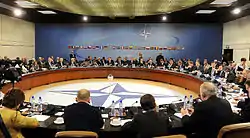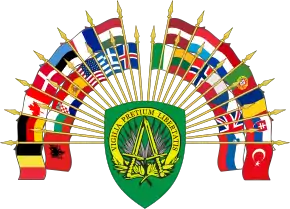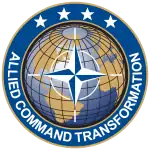North Atlantic Council
The North Atlantic Council (NAC) is the principal political decision-making body of the North Atlantic Treaty Organization (NATO), consisting of Permanent Representatives from its member countries.[1] It was established by Article 9 of the North Atlantic Treaty and it is the only body in NATO that derives its authority explicitly from the Treaty.
North Atlantic Council | |
|---|---|
| History | |
| Founded | April 4, 1949 |
| Leadership | |
Deputy Secretary-General | |
| Seats | |
| Meeting place | |
 | |
| NATO Headquarters Brussels, Belgium | |
| Website | |
| http://www.nato.int/ | |
Powers and duties
The North Atlantic Treaty gave the NAC the power to set up subsidiary bodies for various policy functions, including a defense committee to implement other parts of the treaty. Since 1952, the NAC has been in permanent session.[2] The NAC can be held at the Permanent Representative Level (PermReps), or can be composed of member states' Ministers of State, Defense, or Heads of Government. The NAC has the same powers regardless of the formation under which it meets. The NAC meets twice a week: every Tuesday, for an informal lunch discussion; and every Wednesday for a decision-taking session. Usually, meetings occur amongst the Permanent Representatives who are the senior permanent member of each delegation and is generally a senior civil servant or an experienced ambassador (and holding that diplomatic rank). The list of Permanent Representatives may be found on the NATO website.[3]
The 30 members of NATO have diplomatic missions to the organization through embassies in Belgium. The meetings of the NAC are chaired by the Secretary General and, when decisions have to be made, action is agreed upon on the basis of unanimity and common accord. There is no voting or decision by majority. Each nation represented at the NAC table or on any of its subordinate committees retains complete sovereignty and responsibility for its own decisions.
The NATO Military Command Structure consists of two strategic commands and is directed by the International Military Staff:[4]
The commands under SACEUR - Allied Joint Force Command Brunssum, Allied Joint Force Command Naples and Joint Force Command Norfolk are Operational Level Commands, while Headquarters Allied Air Command, Headquarters Allied Maritime Command and Headquarters Allied Land Command are Tactical Level Commands.[5] SACEUR also has operational command of the Joint Support and Enabling Command.[6]
- Liaison: Provides advice and support to the NAC
| Political strategic level: | |||||||||||||||||||
| NA Council | |||||||||||||||||||
| NATO SG Brussels, BE | IS Brussels, BE | ||||||||||||||||||
| Military strategic level: | |||||||||||||||||||
CMC (NATO MC) | |||||||||||||||||||
 SACEUR (ACO, SHAPE) Mons, BE |  SACT (ACT, HQ SACT) Norfolk, US | ||||||||||||||||||
| Operational level: | |||||||||||||||||||
| JFC-NF Norfolk, Virginia, US | |||||||||||||||||||
References
- "The North Atlantic Council". NATO.
- "REORGANIZATION OF THE NORTH ATLANTIC TREATY ORGANIZATION".
- "nato.int: "NATO Permanent Representatives"".
- "Command Structure" (PDF). NATO. Retrieved October 19, 2019. and "Military Command Structure". shape.nato.int. Supreme Head Allied Powers Europe. February 12, 2020. Retrieved February 12, 2020.
- "MILITARY COMMAND STRUCTURE". shape.nato.int. NATO. October 7, 2020. Retrieved October 7, 2020.
- Boeke, Sergei (January 13, 2020). "Creating a secure and functional rear area : NATO's new JSEC Headquarters". nato.int. NATO. Retrieved October 9, 2020.
JSEC is part of the NATO Force Structure and under the operational command of the Supreme Allied Commander Europe (SACEUR).
Bibliography
- Bumgardner, Sherrod Lewis, ed. (2010). NATO Legal Deskbook (PDF) (2nd ed.). Belgium.